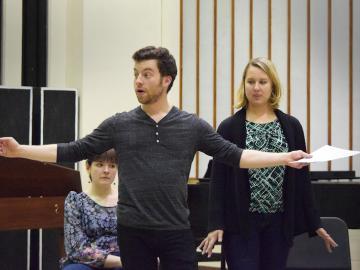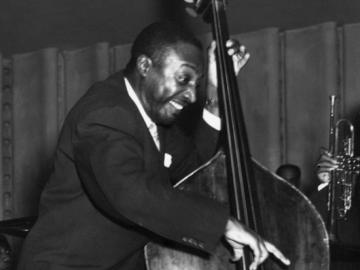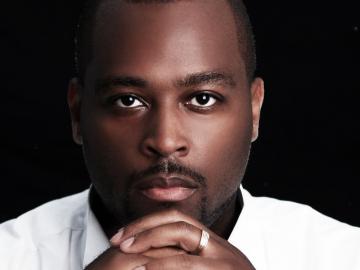Beethoven's body of works woven with the past and present
February 1, 2013
Jessica R. Downs
OBERLIN, OHIO — On Saturday, February 16, the Oberlin Conservatory of Music will present a two-part faculty and guest recital showcasing all of Beethoven’s works for fortepiano and cello. Fortepianist David Breitman, of Oberlin, joins with guest cellist Jaap ter Linden for this odyssey of works performed in the intimate setting of Kulas Recital Hall. Part I begins at 4:30 p.m., and following a break, Part II continues at 8:00 p.m. Admission is free, and the concerts will be streamed live at new.oberlin.edu/conservatory/listenlive.
“Live performances of the cycle are rare,” says Breitman, associate professor of historical performance and director of Oberlin’s historical performance program. He believes this is mainly due to the awkward size of the repertoire in the cycle, hence the reason for dividing the concert into two parts. Five sonatas and three sets of variations comprise the total body of works, captivating listeners with the breadth of Beethoven’s career, from the “youthful exuberance of his early years” to his boundary pushing classical style that demonstrates “daring counterpoint and highly concentrate material.”
During the February 16 concerts, Breitman and ter Linden will work chronologically through the repertoire and perform on period instruments, with Breitman opening Part I on a replica of a Viennese piano, circa 1800. He explained that although the early pieces brilliantly exploit the resources of the five-octave fortepiano, Beethoven subsequently “adapted his style perfectly to take advantage of the evolving instrument—especially remarkable when you consider that these changes were occurring just as he was losing his hearing.” For Part II of the evening, Breitman will perform on a copy of a Viennese Graf piano, circa 1819.
The intimacy of Kulas Hall will illuminate the unique qualities of performing on period instruments through the vehicle of Beethoven’s compositions. “Today’s piano is a behemoth compared to the modest instruments of Beethoven’s time,” Breitman explains. “In our setup, Jaap and I can use the full dynamic range of our instruments. With modern instruments, the pianist’s challenge is to communicate intensity while always being careful not to drown out the cellist; while the cellist needs to make sure at all times to project above the sound of the piano.”
Timbre of the historical instruments plays an important role in the listeners’ experience, as well. The gut strings of the cello match, at times, the reedy timbre of the fortepiano, sometimes to the point that it is difficult to differentiate between the two instruments. “The modern instruments are intrinsically different, and the contrast between them is reinforced by the rich, continuous vibrato of contemporary string players,” Breitman says.
Audience members will have the opportunity to hear the two contrasting setups when Professor of Piano Peter Takács and guest cellist Robert deMaine, recently named principal cellist of the Los Angeles Philharmonic, perform the same program on modern instruments in April. (Information on that event will be released in March.)
Takács remarks, "It will be enlightening to hear the same repertoire in the same space, played on historical and modern instruments. Each performance will highlight distinctions between the two combinations of instruments. The Beethoven cello with piano repertoire is a remarkable body of work, distributed perfectly across the master's compositional evolution. Hearing it twice will be a double bonus for the Oberlin community."
Breitman says that his concert with ter Linden may evoke the past, the intimacy revealing smaller details of articulation; while Takács and deMaine may bring more power and romanticism to their performance, emphasizing the longer lines.
Ultimately, though, Breitman says “both performances will make it obvious that these are seminal works by a composer who changed the course of music.”
There is a modern twist, however, to Breitman and ter Linden’s trip down the piano’s memory lane: Breitman plans to read the music from his iPad, turning pages with a Bluetooth pedal.
Breitman and ter Linden are slated to record the complete works for fortepiano and cello later this summer at Oberlin Conservatory’s premiere recording facility, Clonick Hall.
Fact sheet
Saturday, February 16, 2013
The Complete Works of Beethoven for Fortepiano and Cello
Part I, 4:30 p.m.
Part II, 8:00 p.m.
David Breitman, fortepiano
Jaap ter Linden, cello
Kulas Recital Hall
77 West College Street
Oberlin, Ohio 44074
Free; no tickets are required.
Listen Live! The concerts will be live streamed at new.oberlin.edu/conservatory/listenlive.
About David Breitman
Pianist David Breitman directs the historical performance program at Oberlin. He is equally at home with the fortepiano and the modern piano, and enjoys both solo and ensemble playing. Recent seasons have included Beethoven’s Fourth Concerto and Choral Fantasy on both historical and modern pianos, and several performances at the renowned Cobbe Collection of historical instruments outside of London. His collaboration with baritone Sanford Sylvan spans more than 30 years, with several hundred recitals and four CD’s, ranging from Schubert’s Die schöne Müllerin, to the premiere recording of The Glass Hammer, a major song cycle by the Cuban-American composer Jorge Martin. Breitman has recorded the Mozart piano-violin sonatas on historical instruments with Jean-François Rivest for Analekta, and, in a collaboration of a different sort, he is one of seven fortepianists on the 10-CD recording of the complete Beethoven piano sonata cycle on Claves.
Breitman’s most recent projects involve more Beethoven: a recording of the violin sonatas with Elizabeth Wallfisch will be complete by the end of 2012; the cello sonatas with Jaap ter Linden are projected for 2013. He shares his enthusiasm for this repertoire with students in his course at Oberlin “Performing Beethoven’s violin/cello sonatas,” and is currently working on a book titled Time-Travel for Pianists: How Today’s Players Can Learn from Yesterday’s Instruments.
About Jaap ter Linden
As one of the first early music specialists, Jaap ter Linden witnessed the very beginnings of many of the oldest and finest baroque ensembles as cofounder of Musica da Camera, and as principal cellist of Musica Antiqua Köln, The English Concert, and the Amsterdam Baroque Orchestra. From these auspicious beginnings he moved further into the spotlight, either by playing solo concerts and intimate ensemble repertoire with the world's finest interpreters, or at the helm of an orchestra as conductor.
He founded and directs the Mozart Akademie (with which he has recorded the complete Mozart symphonies) and is a regular guest director and soloist with the Arion Ensemble (Canada). He has led many period instrument orchestras such as the San Francisco Philharmonia Baroque, Portland Baroque, and Amsterdam Bachsoloists, and has lent his expertise to modern ensembles such as the Amsterdam Sinfonietta and the Deutsche Kammerphilharmonie.
Ter Linden’s extensive discography both as a player and as a conductor boasts many award-winning recordings for labels such as Harmonia Mundi, Archiv, ECM, Deutsche Grammophon, and more recently, Brilliant Classics. In 2006, Jaap released his second recording of the Bach Cello Suites.
Most recently, Jaap has dived into the world of opera, conducting Purcelli's King Arthur with the Städtische Bühne Münster and Gluck's Iphigénie en Aulide with the Royal Conservatory of The Hague.
Tags:
You may also like…
Jason Goldberg '16 Leads Oberlin Co-Production of Dido and Aeneas
April 5, 2016
Milt Hinton Institute Returns with Emphasis on Suzuki Instruction
March 31, 2016
Baritone Michael Preacely '01 to Perform, Lead Talks at Oberlin
March 17, 2016


